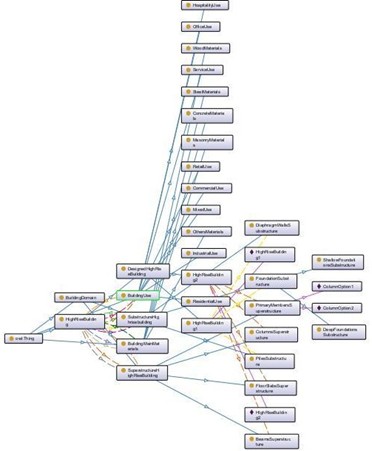Scope and Goal
An structured and standardized representation of building systems, components, materials, and their relationships serves as what the high-rise building ontology was created to fulfill. This ontology incorporates information from parametric design, structural analysis, and Building Information Modeling (BIM) by establishing a hierarchical framework and clear relationships between pieces.
Key Objectives:
✔ Describe the substructure and superstructure of high-rise structures’ structural framework.
Improve the compatibility of various technical, design, and construction tools.
✔ Encourage performance analysis, taking sustainability, energy efficiency, and structural integrity into account.
Permit scalability to accommodate new construction codes, materials, and technology.
This ontology ensures methodical data management by offering a thorough reference for high-rise building design, construction planning, and sustainability assessment.
Intended Users and Application
This ontology is valuable for professionals, researchers, and stakeholders involved in high-rise building projects.
Who Can Use It?
- Architects & Engineers – To evaluate design alternatives, material selection, and structural stability.
- Urban Planners – To analyze the integration of high-rise buildings within urban infrastructure.
- Researchers & Students – To explore structured data models for BIM, parametric design, and sustainability.
- Developers & Modelers – To create performance-driven digital models for construction and facility management.
Application Areas:
- Structural Analysis & Simulation: Evaluating load distribution, seismic resilience, and wind resistance.
- Life-Cycle Assessment (LCA): Assessing environmental impact, energy consumption, and material sustainability.
- Parametric Design: Supporting data-driven modifications for adaptive and efficient high-rise structures.
- Facility Management: Aiding maintenance planning, safety analysis, and building performance monitoring.
By providing a logical and interconnected data framework, this ontology ensures consistency in design, construction, and operational management.
Ontology Summary
The high-rise building ontology is structured as a hierarchical model, classifying building components based on function, material, and performance factors.
Core Elements of the Ontology:
Building Components: Foundation, columns, beams, slabs, walls, roof, and core.
Materials: Concrete, steel, glass, masonry, and insulation.
Design Options: Variants such as office towers, mixed-use skyscrapers, and residential high-rises.
Performance Metrics: Structural stability, energy efficiency, cost, and sustainability.
Ontology Properties: Defined relationships between components, such as:
- hasSubStructure (e.g., A high-rise building has a foundation and piles).
- hasSuperStructure (e.g., The building includes columns, beams, and slabs).
- hasMaterial (e.g., A column is made of steel or reinforced concrete).
- hasPerformanceMetric (e.g., A façade system impacts energy efficiency and ventilation).
By defining clear relationships and constraints, the ontology ensures logical consistency and meaningful data representation.
Class Hierarchy
The hierarchical structure classifies each building element based on its function and relationship with other components.
Top-Level Class: High-Rise Building
Design Options
- Design 1
- Design 2
Building Components
Substructure: Foundation, Diaphragm Walls, Piles
Superstructure: Columns, Beams, Floor Slabs, Core
Architectural Elements: Windows, Façade Systems, Roofing
Materials
- Concrete
- Steel
- Glass
Performance Metrics
- Structural Integrity
- Construction Cost
- Durability & Maintenance Needs
Each building component is linked to materials and performance attributes, creating a comprehensive and scalable data model.
Ontology Visualization
To better understand the relationships between structural components, materials, and performance factors, we have visualized the ontology using Protégé’s OntoGraf tool.
This interactive visualization helps explore how different elements interconnect within the high-rise building framework.
Conclusions
The high-rise building ontology offers a structured, scalable, and logically consistent representation of a skyscraper’s components and attributes. By establishing explicit relationships between elements, the ontology enhances data integration, decision-making, and sustainability analysis in modern high-rise construction.
By applying this ontology in real-world projects, we can improve design optimization, lifecycle assessment, and urban development strategies, ensuring efficient, sustainable, and high-performance high-rise buildings.
